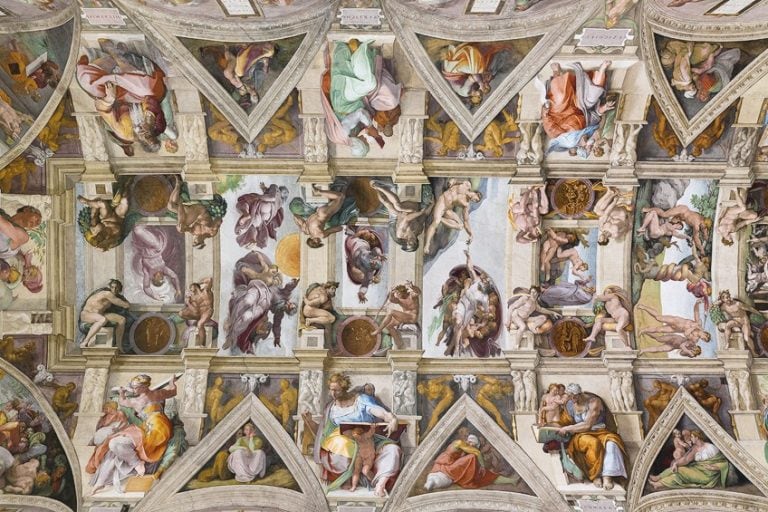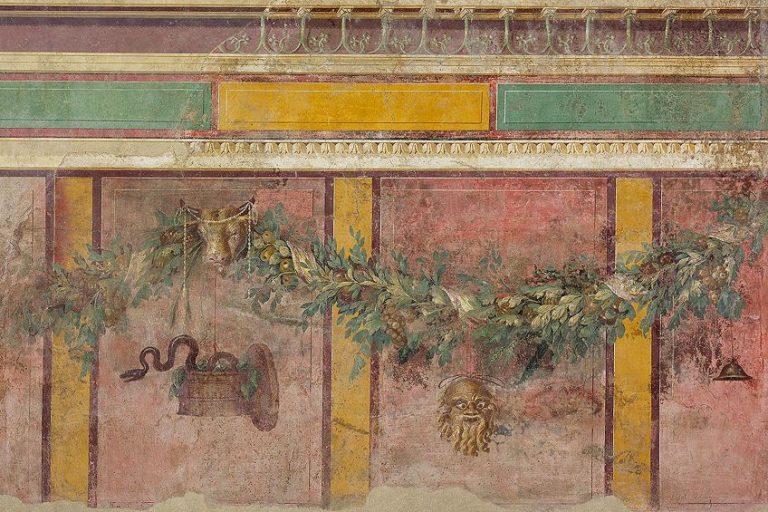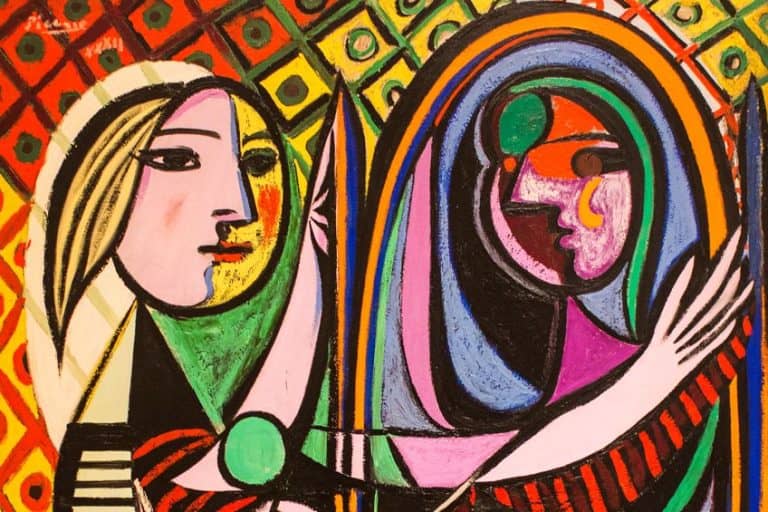“The Two Fridas” by Frida Kahlo – Double Self-Portrait Analysis
Frida Kahlo’s double self-portrait, The Two Fridas (1939), illustrates the artist’s fraught relationship with heartbreak, self-identity, gender, and sadness. It is a painting with many faces, so to say, which we will explore in more depth in the article below.
Artist Abstract: Who Was Frida Kahlo?
Frida Kahlo was a prominent Mexican artist who was born July 6, 1907, in the Mexican village of Coyoacán. Kahlo was one of the famous female artists from the 20th century, producing paintings that delved into the questions around gender, identities, race, politics, nationality, sexuality, and the pains of being a human being.
She was famous for her numerous self-portraits and paintings that celebrated her Mexican ancestry and heritage.
She was married to Diego Rivera, a famous Mexican painter, and was part of several political groups throughout her life. Her style of art has been described as falling within the scopes of Naïve Art, Magical Realism, and Surrealism. Due to a severe car accident when she was aged 18, she always suffered from chronic pain and underwent numerous surgeries, which left her bedridden for significant periods. She died July 13, 1954, from what was believed to be a pulmonary embolism, but some state it was from an overdose of her medication.

The Two Fridas (Las Dos Fridas) (1939) by Frida Kahlo in Context
The Two Fridas painting, titled Las dos Fridas in Spanish, was one of Kahlo’s largest paintings. It was a poignant presentation of her inner emotional world depicted by two images of herself. Below we will discuss The Two Fridas analysis further.
First, we will provide a brief contextual background looking at the events in Kahlo’s life when she painted Las dos Fridas. We will then provide a formal analysis of the painting, looking at the subject matter and various stylistic elements she employed, including why we cannot exactly categorize this as a wholly Surrealist painting.
| Artist | Frida Kahlo |
| Date Painted | 1939 |
| Medium | Oil on canvas |
| Genre | Portrait painting |
| Period / Movement | Surrealism, Symbolism, Naïve Art |
| Dimensions | 173.5 x 173 centimeters |
| Series / Versions | Not applicable |
| Where Is It Housed? | Museo de Arte Moderno, Mexico City |
| What It Is Worth | Purchased for 4,000 Pesos in 1947 by the Nacional de Bellas Artes, Mexico City. |
Contextual Analysis: A Brief Socio-Historical Overview
When Frida Kahlo produced The Two Fridas painting it was 1939, the same year when she and her husband, Diego Rivera, who was a famous and prolific Mexican artist, divorced. Although sources state that the couple split whilst remaining amicable. However, before their divorce, Kahlo and Rivera traveled throughout the United States to support his art career; he had a couple of commissions and exhibitions.
Kahlo also painted while she traveled, having already started her artistic profession.
When they returned from the United States in 1933 and lived in San Ángel in Mexico, however, the couple did not experience a harmonious relationship and soon both had affairs, of which, Rivera had an affair with Frida’s sister, Cristina Kahlo. Frida also experienced significant health issues that undoubtedly contributed to her suffering.

Early in 1939, Frida also traveled to Paris by the Surrealist André Breton’s invitation to hold her second Surrealist exhibition. He reportedly met her in 1938 when he visited Mexico. She first exhibited as a solo artist in New York at Breton’s acquaintance, Julien Levy’s, gallery. Frida traveled alone during this time while Rivera was in Mexico.
It was apparently when she returned from her travels that Rivera wanted a divorce, however, this also marked a turning point for Frida’s art career. The Mexican artist started creating larger paintings and endeavored to support herself with her art career.
It is important to note that Kahlo and Rivera’s relationship was tumultuous, and the couple remarried again after their divorce.
Frida Kahlo: Standing Between Identities
It is also important to note that Frida Kahlo was a multi-faceted woman with a strong political sense about her. From a young age, she was always interested in politics and grew up during the Mexican Revolution. She was a member of the Mexican Communist Party in 1927 and in 1936 she joined the socialist group called the Fourth International.
Frida and Diego also housed Leon Trotsky, who was a Ukrainian politician and revolutionary leader, and his wife, Natalia Sedova, from 1937 to 1939. During Trotsky’s stay, he and Kahlo had an affair, which was also the reason that led him and his wife to move.

Kahlo was deeply connected to her Mexican heritage and always expressed her national pride through her artwork. We will see this in numerous paintings where she references the Tehuantepec culture, which is usually referred to as Tehuana, through the dresses she wore, which, additionally, was a style Diego liked to see her wear too.
If we look deeper at Kahlo’s connection to her Mexican heritage, she was also involved in what was known as the Mexicanidad movement. This was a post-revolution movement, which sought to embrace Mexican ancestry and all its traditions through art; it has also been described as a “romantic nationalism”.
Kahlo also included various symbols that she derived from the mythology and traditions of the Aztecs and other Mexican cultural motifs. In numerous examples, we will see how she inserts traditional imagery denoting her national pride.
Examples include her painting My Dress Hangs There (1933), which she painted at a time when she traveled America with Rivera, but she apparently longed to go back to Mexico. We also see this disparity of place in Self-portrait on the Borderline between Mexico and the United States (1932), where she stands with a traditional Victorian dress holding a Mexican flag. However, in this painting, we also notice an Aztec building, traditional sculptures, and what appears to be fertility statuettes.
Furthermore, Frida did not solely share Mexican roots; she shared European ancestry through her parents. Her father, who was Carl Wilhelm Kahlo, his Spanish name was Guillermo Kahlo, was from Germany, and her mother, who was Matilde Calderon y Gonzalez, had Spanish and indigenous roots.
Through this intersection with the European and traditional, Kahlo was undoubtedly connected to a diverse set of identities that she inherited, but she also adopted the identities that she felt the most connection with, and she illustrated this throughout her paintings.
Kahlo was never afraid to show herself in all her glitz and gore, often utilizing motifs related to human anatomy, surgery, and blood. This was due to her interest in science, more so medicine, which she pursued to study after school until a severe vehicular accident changed the course of her life.
When she was 18 years old, she was involved in a collision between a bus and a car. She suffered numerous fatal injuries that left her with lifelong chronic pain. The tragedy from this event propelled her even further into her art career and it became a subject of many of her paintings, one example is a later painting The Broken Column (1944).
Conversely, she also touched on sexual, gender, and racial stereotypes, questioning her role as a woman, and more so, a Mexican woman living in a turbulent world of clashing identities. In one of her later paintings, Self-Portrait with Cropped Hair (1940), we see how she bridges the gap between masculine and feminine identities by depicting herself in a suit with short hair, resembling Diego Rivera himself.
Formal Analysis: A Brief Compositional Overview
Below we look at The Two Fridas analysis discussing it in more detail. There are various motifs and details in this painting, and without a bit of history about Frida Kahlo as an artist, and the circumstances that surrounded her at the time she painted it, this Las dos painting would not be appreciated to its fullest.

Subject Matter
In The Two Fridas by Frida Kahlo, we see two women seated on what appears to be a wicker bench, staring directly at us, the viewers, in an ambivalent and almost empty gaze. However, on closer inspection, we will see the two women are both Frida Kahlo.
Both Fridas are holding each other’s hands; the Frida to our left has her left hand over the right hand of the Frida to our right.

Additionally, we will notice that both Fridas’ hearts are exposed and connected, one to the other, by a red vein. From this vein other veins branch off, connecting to two items held by Frida on their laps; the Frida to our left holds a pair of surgical scissors and the Frida to our right holds a miniature oval portrait.
Starting with the Frida to our left, she is wearing a full-length white dress which appears to be a Victorian costume. Some sources state this is a wedding dress, reminiscent of the dress depicted on Kahlo’s mother in her painting My Grandparents, My Parents, and I (Family Tree) (1936).
The dress is decked with lace and frills covering her entire body, including her whole neck leaving only her forearms open to the world as well as her heart. Looking at her heart, where the dress is torn in this area, it appears to be cut open exposing the ventricles inside it even further. In her right hand, the Frida to our left is a pair of surgical scissors. As we mentioned above, these appear to have been used to cut the vein, which now clamps it stopping the blood flow.
This vein is connected to another vein that links to the other Frida.
There are also drips of blood staining Frida’s white dress in two areas, almost matching the pattern along the bottom of her dress made up of what appears to be red flowers. This seemingly alludes to the beauty and fairness implied by the white dress being lost by the smearing of blood on it.
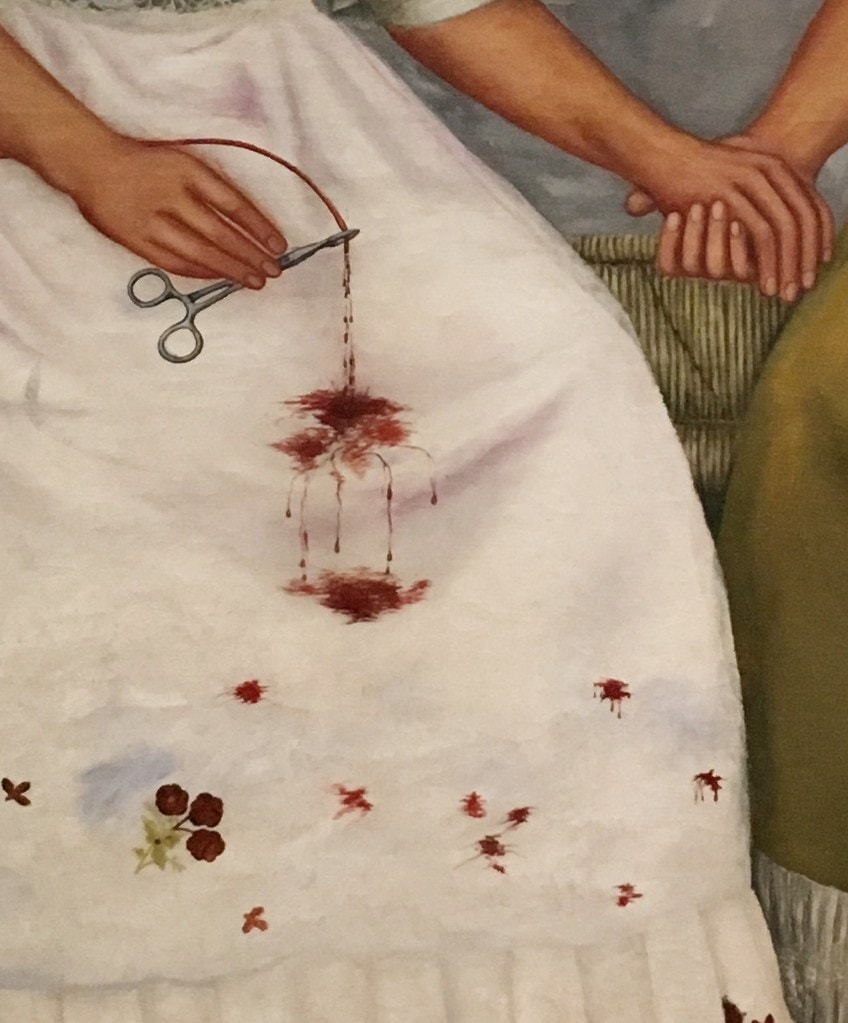
If we move to the Frida to our right, she is wearing a traditional Tehuana costume consisting of a blue, short-sleeved, blouse with yellow patterned lines, and a long brown/green skirt with white lace trim at the bottom. We see more of Frida’s arms and neck here and her heart is depicted without any cuts on it, appearing “healthier” than the other Frida’s heart.
Additionally, her heart appears superimposed on top of her blouse, which is also intact and not torn like the other Frida’s dress.
In her left hand, the Frida to our right is a small oval portrait between her thumb and forefinger, which is connected to a vein that connects to her heart. If we look at the portrait, we will notice that Kahlo depicted an image of Diego Rivera when he was a child.

If we look at the setting of The Two Fridas painting, around two-thirds of the background consists of a darkened cloud-filled sky, as if a storm is brewing. The lower third of the background is the ground or floor, it appears brown, which suggests that it is possibly a grounded surface.
Color
The Two Fridas painting was painted in oils, which was a medium Kahlo regularly utilized for most of her paintings. She did not utilize too many bright colors; in fact, most of the color palette appears in neutral tones, even the yellow and red are not overly bright.
There is also a somber ambiance created by the dark colors of the sky in the background.
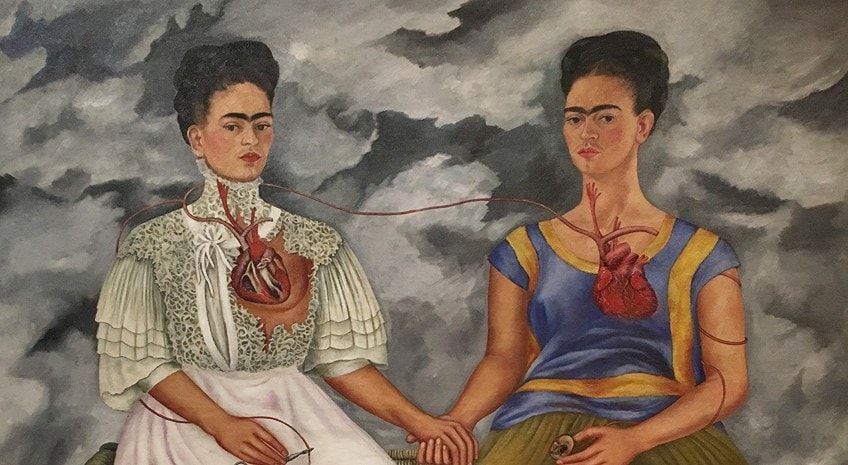
Perspective and Scale
If we look at the perspective and scale of The Two Fridas, it depicts a simple setting that is not significantly three-dimensional; the background appears close to the subject matter in the foreground. However, we will notice various aspects of shading, such as where the sky and ground meet, which do give the idea of space and three-dimensionality.
The “Two Fridas” painting also measures 173.5 x 173 centimeters, which has been described by various art history sources to be one of Kahlo’s larger artworks because she was known to paint on smaller scales.
She was also known for painting on smaller scales, which were in the style reminiscent of votive paintings, called retablos in Spanish. These were religious paintings created as devotional offerings, which originated from Catholic traditions. Apparently, Kahlo had around 2000 votive paintings in her art collection. It would indeed have been a change for Kahlo to produce a life-sized painting when it seemed a custom for her to paint and collect smaller paintings.
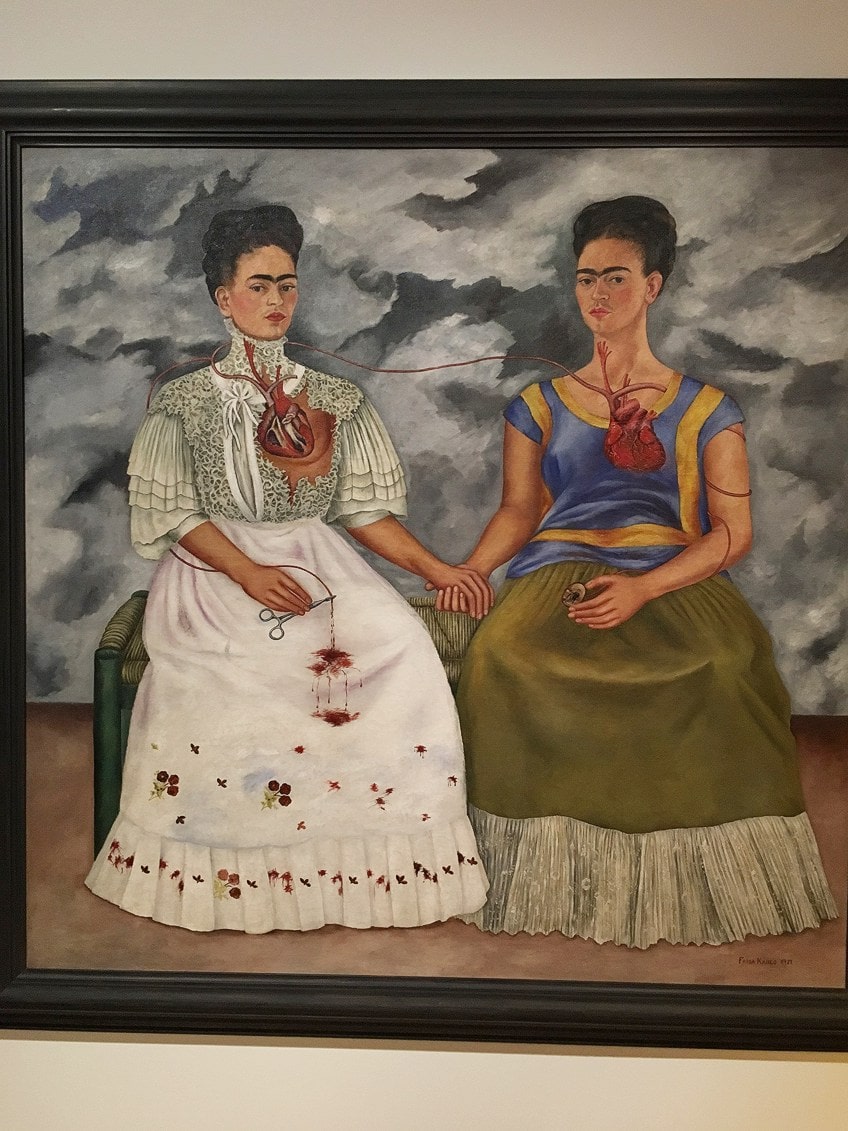
The Two Fridas Meaning
There is a lot that can be said about The Two Fridas by Frida Kahlo; it is a key to the inner recesses of Kahlo’s heart and heritage. Whether or not the artist intentionally left it open to interpretation for us, the viewers, or simply just painted what she felt due to her heartbreak and pain, nonetheless, it holds many meanings, and maybe Kahlo painted it with many meanings in mind.
“The Two Fridas” meaning could possibly be allocated to four different explanations that the artist incorporated in her painting, namely and most importantly, the hurt and sadness from her divorce from Diego Rivera.
The other three meanings could be around the chronic pain she always experienced due to the near-fatal accident when she was younger, her indigenous Mexican and European heritage, and the schism this may have formed within her identity as a woman, and lastly, some sources state that Kahlo referred to her imaginary friend when she was growing up, which the artist could be alluding to in her painting here.
It is interesting to note that some sources also refer to Kahlo’s earlier oil painting Frieda and Diego Rivera (1931), which depicts the couple standing together holding each other’s hands. This has been a part of the question as to why Frida Kahlo painted her own double self-portrait, and part of uncovering its meaning, some relate to her significant relationship with Rivera.
The painting, Frieda and Diego Rivera, was produced as a portrait of the couple indicating their wedding and married life. In this painting we notice how their hands barely touch, Frida’s right hand, our left, is just clasping Diego’s left hand, our right, which is underneath.
Similarly, there are numerous meanings in this painting, and Kahlo undoubtedly hinted at what was beyond just a “happy marriage”, subtly pointing to her husband’s affairs, questioning the stability of their marriage.
We see this similar hand-holding in Frida’s “Las Dos” painting. However, here, Frida is holding her own hand, which could possibly indicate a new type of marriage she underwent with herself, deepening her relationship with herself.
This ultimately gives her masterwork painting a deeper meaning altogether, showing us how she held her own hand through her heartbreak and pain, holding her own hand as she walked across the bridge that gapped her role as a woman in a European world and a woman in a Mexican world. It has become her emblem of courage and bravery in a world that seemed wholly dualistic.
Frida Kahlo: Two Sides of the Same Coin
Frida Kahlo’s The Two Fridas left a significant impact and inspired many others. It has been described as a “cultural symbol” and has been re-enacted in the play from 1998, Las Dos Fridas. Beyond the above, Kahlo has been honored in many pop-cultural references, including film, music like the song Frida Kahlo’s Visit to the Taybridge Bar by Michael Marra, books like the children’s publication Frida Kahlo and her Animalitos (2017), and various authors like Barbara Kingsolver’s novel The Lacuna (2009), as well as various other plays.
In The Two Fridas Kahlo depicts two sides of herself that are wholly different; the one side that is seemingly broken and in pain, bleeding out so to say, and the other side that is seemingly strong and whole, rooted in her heritage and love with Rivera. She ultimately shows us two sides of the same coin: while she has two sides, she is still one person, multifaceted and simultaneously experiencing various emotions.
Frida Kahlo used herself as the model and recipient of deeper meanings pictured through her paintings. Some sources describe her as using her body as the “metaphor” in addressing these various issues. She showed us many facets of herself and in almost all her paintings she wore her heart wide open for the world to see. She was not only an artist at heart but a woman with a tremendous soul.
Frequently Asked Questions
What Does Frida Kahlo’s The Two Fridas (1939) Mean?
The Two Fridas (1939) painting has different meanings, but it was painted when Kahlo was going through a divorce with her husband Diego Rivera, depicting her heartbreak and sadness. It also symbolizes Kahlo’s different identities, namely her European and Mexican identities, evident in the dresses she wears. Furthermore, some have also said that it refers to her imaginary childhood friend.
When Was The Two Fridas (1939) Exhibited?
The Two Fridas (1939) by Frida Kahlo was exhibited in 1940 at the International Surrealist Exhibition, which was held in Mexico. Kahlo met the Surrealist pioneer, André Breton in 1938. Through him, she exhibited in Paris and New York City, however, she never considered herself a Surrealist painter. Her style was more like Magical Realism, which was a combination of reality and fantasy.
Where Is The Two Fridas (1939) Painting?
Frida Kahlo’s The Two Fridas (1939) painting is housed at the Museo de Arte Moderno in Mexico City, which has reportedly been there since 1966. It was first bought by the Instituto Nacional de Bellas Artes, which was during 1947, and before then it was still held by Frida Kahlo.
What Identities Are Frida Kahlo Portraying in The Two Fridas (1939)?
The Two Fridas (1939) depicts Frida Kahlo in two different dresses, one dress is a classic Victorian wedding dress, which covers her entire body and gives the idea of conservatism and rigidness, while the other dress is from the Tehuana culture, which is more colorful and appears freer and less restricted. It also reveals more of Kahlo’s skin where the white dress covers most of her body. The two dresses symbolize two different cultures that were part of Kahlo’s life, namely the European and Mexican cultures.
Alicia du Plessis is a multidisciplinary writer. She completed her Bachelor of Arts degree, majoring in Art History and Classical Civilization, as well as two Honors, namely, in Art History and Education and Development, at the University of KwaZulu-Natal, South Africa. For her main Honors project in Art History, she explored perceptions of the San Bushmen’s identity and the concept of the “Other”. She has also looked at the use of photography in art and how it has been used to portray people’s lives.
Alicia’s other areas of interest in Art History include the process of writing about Art History and how to analyze paintings. Some of her favorite art movements include Impressionism and German Expressionism. She is yet to complete her Masters in Art History (she would like to do this abroad in Europe) having given it some time to first develop more professional experience with the interest to one day lecture it too.
Alicia has been working for artincontext.com since 2021 as an author and art history expert. She has specialized in painting analysis and is covering most of our painting analysis.
Learn more about Alicia du Plessis and the Art in Context Team.
Cite this Article
Alicia, du Plessis, ““The Two Fridas” by Frida Kahlo – Double Self-Portrait Analysis.” Art in Context. March 13, 2022. URL: https://artincontext.org/the-two-fridas-by-frida-kahlo/
du Plessis, A. (2022, 13 March). “The Two Fridas” by Frida Kahlo – Double Self-Portrait Analysis. Art in Context. https://artincontext.org/the-two-fridas-by-frida-kahlo/
du Plessis, Alicia. ““The Two Fridas” by Frida Kahlo – Double Self-Portrait Analysis.” Art in Context, March 13, 2022. https://artincontext.org/the-two-fridas-by-frida-kahlo/.




